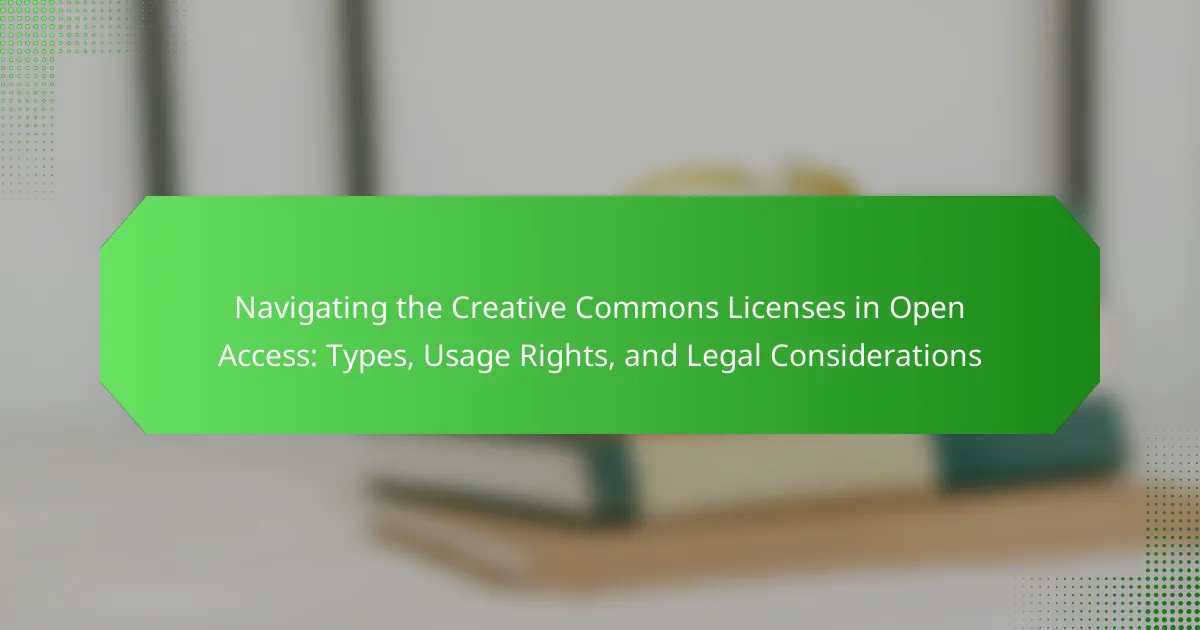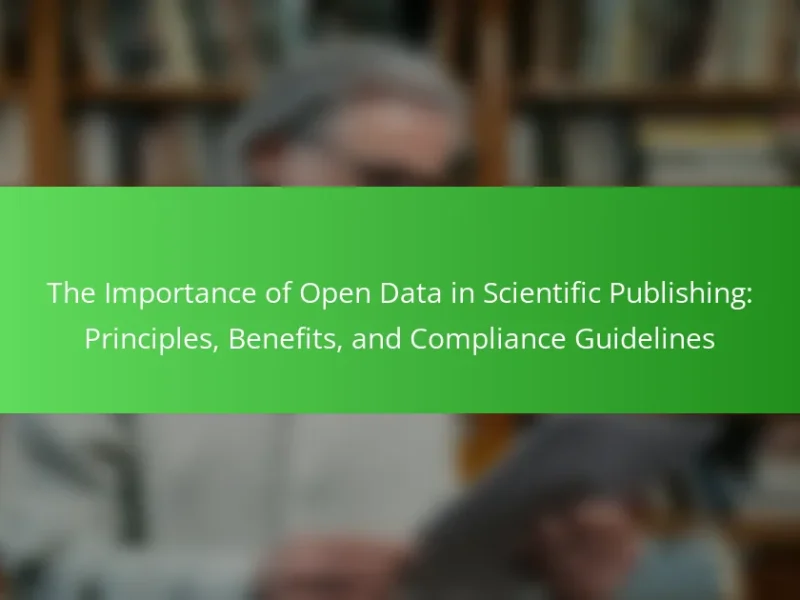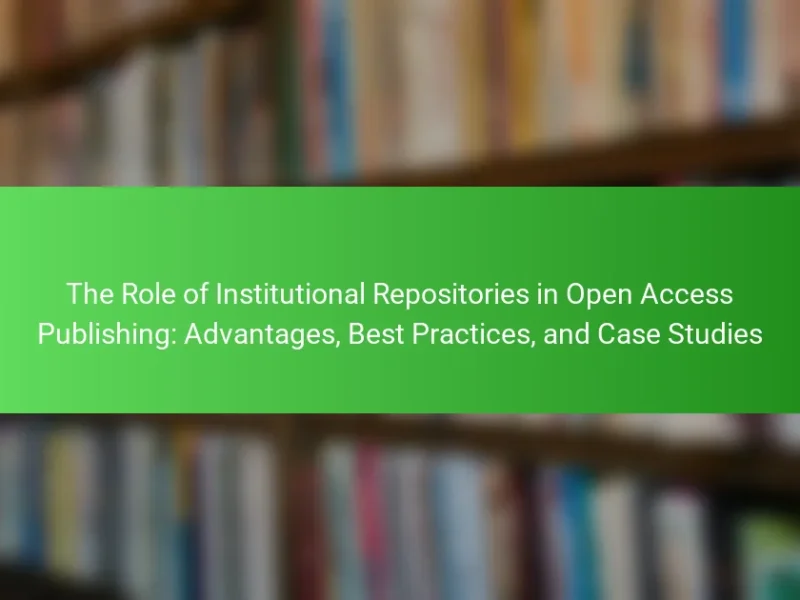Creative Commons licenses are legal frameworks that enable creators to share their works with specific permissions, facilitating the legal use, distribution, and adaptation of creative content. This article provides an overview of the various types of Creative Commons licenses, detailing the permissions they grant, such as commercial use or attribution requirements. It also addresses important legal considerations for users, including compliance with copyright laws and the implications of modifying licensed works. Understanding these licenses is essential for both creators and users to navigate the landscape of open access effectively while protecting intellectual property rights.
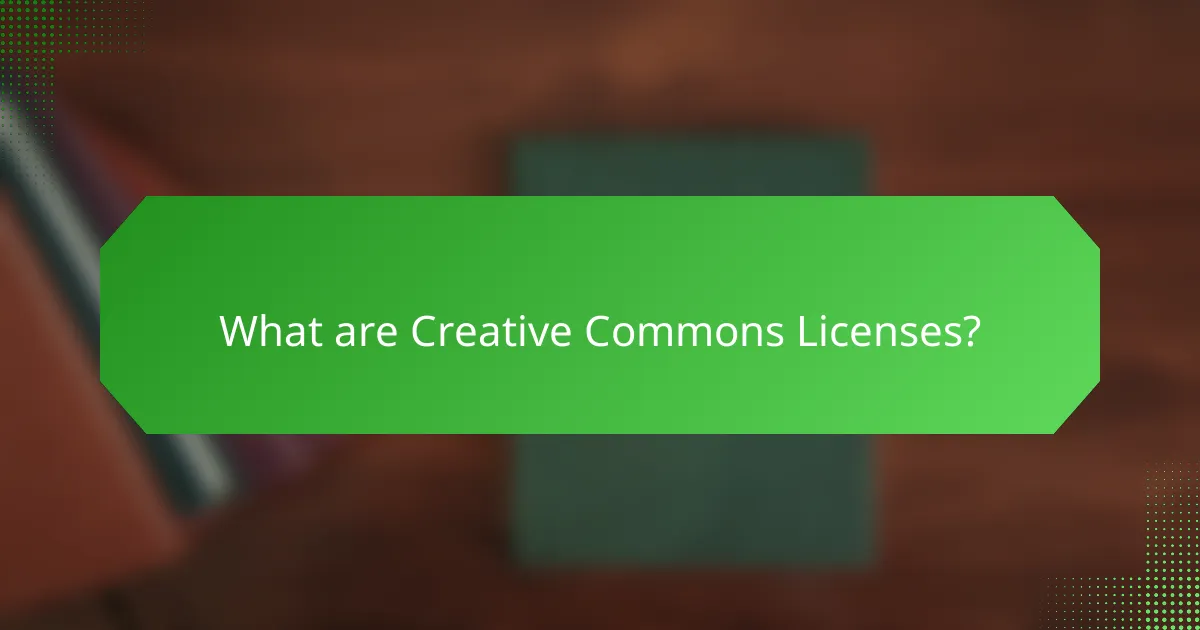
What are Creative Commons Licenses?
Creative Commons licenses are legal tools that allow creators to share their work with specific permissions. These licenses enable users to copy, distribute, and adapt the work under defined conditions. There are several types of Creative Commons licenses, each varying in the permissions granted. For example, some licenses allow commercial use, while others do not. Additionally, some require attribution to the original creator. Creative Commons licenses are recognized globally and facilitate open access to creative content. They are designed to enhance the sharing of knowledge and creativity while protecting the rights of creators.
How do Creative Commons Licenses differ from traditional copyright?
Creative Commons Licenses allow creators to grant specific usage rights to their works, while traditional copyright automatically grants exclusive rights to the creator. Creative Commons Licenses enable sharing and adaptation under defined conditions. Traditional copyright typically restricts use, requiring permission for any reproduction or modification. Creative Commons promotes collaboration and access, facilitating the sharing of knowledge. In contrast, traditional copyright often limits distribution, leading to potential barriers for users. Creative Commons Licenses are designed to be user-friendly and flexible, with clear terms for use. Traditional copyright can be complex, often requiring legal consultation for clarity.
What are the key components of Creative Commons Licenses?
Creative Commons Licenses consist of six key components. These components include Attribution, ShareAlike, NonCommercial, NoDerivatives, Public Domain Dedication, and Public Domain Mark. Attribution requires users to credit the original creator. ShareAlike allows derivative works under the same license. NonCommercial restricts use to non-commercial purposes. NoDerivatives prohibits modifications to the original work. Public Domain Dedication allows creators to waive all rights. Public Domain Mark indicates works that are free of copyright. Each component defines how others can use the licensed material.
Why are Creative Commons Licenses important for open access?
Creative Commons Licenses are important for open access because they provide a standardized way to share and use creative works legally. These licenses allow creators to specify how others can use their work, promoting greater accessibility and collaboration. By using Creative Commons Licenses, authors can retain their copyright while enabling free distribution and modification of their work. This fosters an environment where knowledge and resources are more readily available to the public. Research shows that open access materials increase visibility and citation rates for authors, enhancing academic impact. Additionally, Creative Commons Licenses help clarify usage rights, reducing legal ambiguities for users and creators alike.
What types of Creative Commons Licenses are available?
There are six main types of Creative Commons licenses. These licenses allow creators to specify the permissions for use of their work. The types are:
1. CC BY (Attribution) – Allows others to distribute, remix, adapt, and build upon the work, even commercially, as long as they credit the creator.
2. CC BY-SA (Attribution-ShareAlike) – Similar to CC BY, but requires new creations to be licensed under identical terms.
3. CC BY-ND (Attribution-NoDerivs) – Allows for redistribution, commercial and non-commercial, as long as the work is passed along unchanged and in whole.
4. CC BY-NC (Attribution-NonCommercial) – Allows others to remix, adapt, and build upon the work non-commercially, and although new works must also acknowledge the creator, they don’t have to license their derivative works on the same terms.
5. CC BY-NC-SA (Attribution-NonCommercial-ShareAlike) – Similar to CC BY-NC, but requires new creations to be licensed under identical terms.
6. CC BY-NC-ND (Attribution-NonCommercial-NoDerivs) – The most restrictive license, allowing others to download the works and share them with others as long as they credit the creator, but they can’t change them in any way or use them commercially.
These licenses provide a flexible range of protections and freedoms for authors, artists, and educators.
What are the main categories of Creative Commons Licenses?
The main categories of Creative Commons Licenses are Attribution (CC BY), Attribution-ShareAlike (CC BY-SA), Attribution-NoDerivs (CC BY-ND), Attribution-NonCommercial (CC BY-NC), Attribution-NonCommercial-ShareAlike (CC BY-NC-SA), and Attribution-NonCommercial-NoDerivs (CC BY-NC-ND). Each license allows different levels of sharing and modification. For example, CC BY permits users to distribute, remix, adapt, and build upon the work, even commercially. CC BY-SA requires derivatives to be licensed under the same terms. CC BY-ND allows for redistribution only without modifications. CC BY-NC restricts use to non-commercial purposes. CC BY-NC-SA combines non-commercial use with share-alike requirements. CC BY-NC-ND is the most restrictive, allowing only non-commercial use without modifications. These categories are designed to give creators flexibility in how they share their work.
How do attribution licenses work?
Attribution licenses allow creators to permit others to use their work under specific conditions. These licenses require users to give appropriate credit to the original creator. Users must indicate if changes were made to the original work. Attribution licenses promote sharing while ensuring the creator retains recognition. They are commonly used in Creative Commons licenses. For example, the CC BY license allows for redistribution, adaptation, and commercial use with proper attribution. This framework encourages collaboration and the dissemination of knowledge while respecting creators’ rights.
What are the differences between non-commercial and share-alike licenses?
Non-commercial licenses restrict the use of a work to non-commercial purposes only. Users cannot profit from the work under these licenses. Share-alike licenses allow users to modify and distribute the work, but require derivative works to be licensed under the same terms. The share-alike condition encourages open sharing and collaboration. Non-commercial licenses do not impose such conditions on derivative works. Both license types promote different aspects of sharing and usage. Non-commercial focuses on the absence of profit, while share-alike emphasizes the continuity of open licensing.
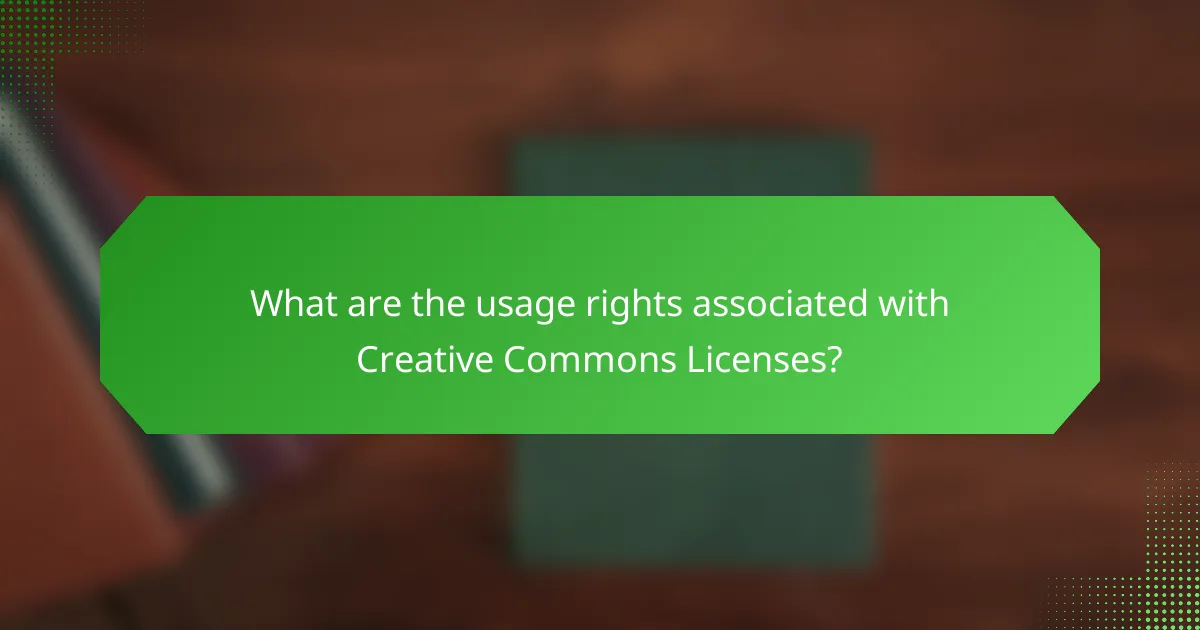
What are the usage rights associated with Creative Commons Licenses?
Creative Commons Licenses provide specific usage rights for creators and users. These licenses allow others to share, use, and build upon creative works legally. The rights vary depending on the type of Creative Commons License. Some licenses permit commercial use, while others do not. Certain licenses require attribution to the original creator. Others impose restrictions on derivative works. For example, the CC BY license allows maximum freedom, while the CC BY-NC license restricts commercial use. The licenses are designed to enhance sharing and collaboration while protecting creators’ rights. Each license is clearly defined on the Creative Commons website, ensuring users understand their rights and obligations.
How can users determine their rights under different licenses?
Users can determine their rights under different licenses by reviewing the specific license terms. Each license type, such as Creative Commons, outlines permissions and restrictions. Users should examine the license type, which is usually indicated by icons or text. The license will specify whether commercial use is allowed or if attribution is required. Users can find detailed explanations of license terms on official websites. For Creative Commons licenses, the organization provides clear guidelines and examples. Understanding these details helps users comply with legal requirements. Additionally, users can consult legal experts for clarification if needed.
What does “attribution” mean in the context of usage rights?
Attribution in the context of usage rights refers to the requirement to credit the original creator of a work. This practice is essential in Creative Commons licenses, which often stipulate that users must acknowledge the author or source when using the work. Proper attribution ensures that creators receive recognition for their contributions. It also promotes transparency and respect within the creative community. Failure to provide attribution can lead to legal repercussions. This principle is foundational in maintaining ethical standards in the use of creative content.
What restrictions are placed on non-commercial licenses?
Non-commercial licenses restrict the use of content to non-profit purposes only. Users cannot sell or profit from the licensed material. These licenses often require attribution to the original creator. Additionally, they may prohibit derivative works or modifications. Non-commercial licenses aim to protect the creator’s rights while allowing free access. For example, Creative Commons licenses specify these restrictions clearly in their terms. Users must adhere to these limitations to avoid legal issues.
What are the implications of using Creative Commons Licenses for creators?
Creative Commons Licenses allow creators to share their work while retaining certain rights. These licenses provide flexibility in how works can be used, modified, and distributed. Creators can choose licenses that align with their preferences for attribution, commercial use, and derivative works. This choice impacts how their work is perceived and used by others. For instance, a license that permits commercial use may lead to wider distribution but less control over how the work is used. Conversely, a more restrictive license can limit exposure but protect the creator’s original intent. Research indicates that works under Creative Commons Licenses often receive more visibility and engagement, benefiting creators in terms of audience reach. Thus, using these licenses can enhance a creator’s reputation while balancing control and accessibility.
How do licenses affect the distribution of creative works?
Licenses significantly influence the distribution of creative works by defining the permissions granted to users. They establish the legal framework that dictates how a work can be used, shared, or modified. For example, a Creative Commons license allows creators to specify whether others can remix, adapt, or use their work commercially. This clarity helps prevent misuse and ensures that creators receive appropriate credit and compensation. According to a study by the Pew Research Center, 87% of creators feel that licenses help protect their rights and intentions for their works. Thus, licenses play a crucial role in shaping the accessibility and reach of creative content.
What responsibilities do creators have when using Creative Commons Licenses?
Creators using Creative Commons Licenses must adhere to specific responsibilities. They must provide appropriate attribution to the original creator. This includes crediting the creator in the manner specified by the license. Creators must not apply legal terms or technological measures that restrict others from using the work. They should also ensure that their use of the licensed material complies with the terms of the specific Creative Commons License chosen. Additionally, if modifications are made, creators must indicate if changes were made to the original work. It is essential that creators respect the moral rights of the original authors. Failure to comply with these responsibilities can lead to legal repercussions. These guidelines help maintain the integrity of the Creative Commons framework.
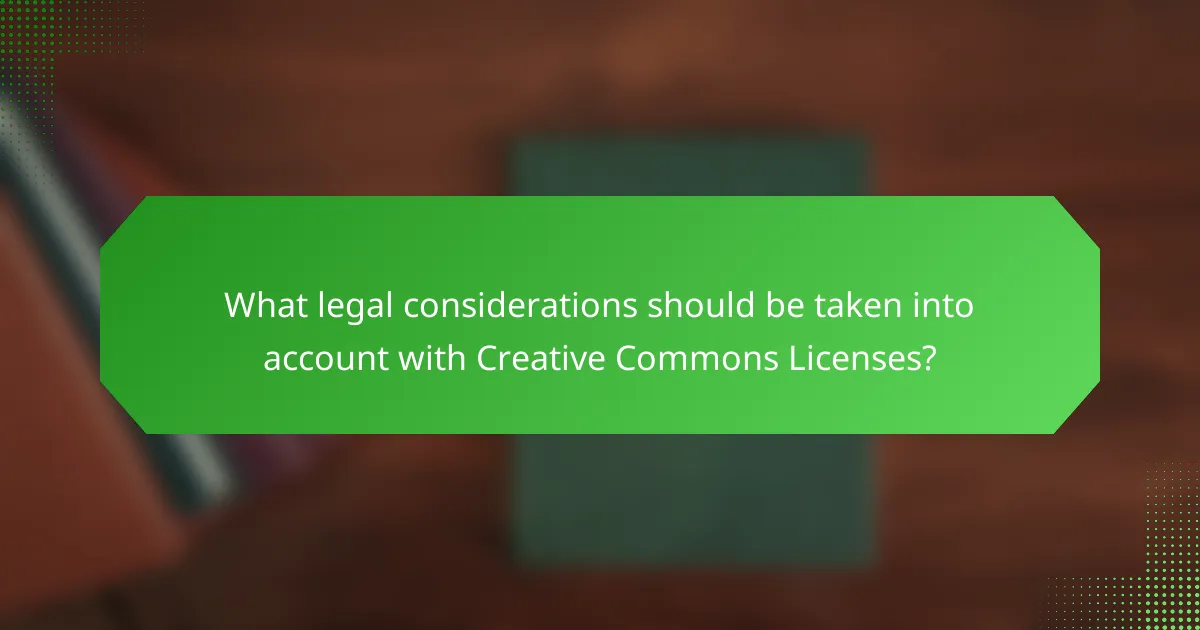
What legal considerations should be taken into account with Creative Commons Licenses?
Creative Commons licenses require careful legal consideration to ensure compliance with copyright laws. Users must understand the specific terms of each license type, which may include attribution, non-commercial use, or share-alike provisions. Misunderstanding these terms can lead to legal disputes. Additionally, the original creator retains certain rights even after licensing. It is crucial to verify that the work being used is not under additional restrictions. Users should also consider the jurisdictional differences in copyright law that may affect license enforcement. Lastly, modifications to the licensed work may require additional permissions depending on the license type.
What are the potential legal risks of using Creative Commons Licenses?
Using Creative Commons Licenses can pose several legal risks. One significant risk is misinterpretation of the license terms. Users may not fully understand the specific permissions and restrictions outlined in the license. This misunderstanding can lead to unauthorized use of the work, resulting in copyright infringement.
Another risk involves the attribution requirement. Failing to properly credit the original creator can lead to legal disputes. Additionally, some Creative Commons Licenses have non-commercial clauses. Violating these clauses by using the work for commercial purposes may result in legal action.
Moreover, derivative works can also create complications. If a user modifies a work without adhering to the terms of the license, this can lead to legal consequences. Lastly, the lack of legal precedent in some jurisdictions regarding Creative Commons can create uncertainty. This ambiguity may expose users to unexpected legal challenges.
How can misunderstandings about license terms lead to legal issues?
Misunderstandings about license terms can lead to legal issues by causing unauthorized use of copyrighted material. When individuals misinterpret the permissions granted by a license, they may inadvertently infringe on the rights of the original creator. For example, a Creative Commons license may allow for sharing but not for commercial use. If someone uses the material for profit without proper authorization, they can face legal action. Additionally, failing to attribute the creator as required by the license can also result in copyright violations. Legal disputes often arise from these misunderstandings, leading to costly litigation and potential damages.
What steps can creators take to protect themselves legally?
Creators can protect themselves legally by using clear contracts and agreements. These documents should outline rights and responsibilities. Additionally, creators should register their work with copyright offices. This provides legal recognition and protection. Using Creative Commons licenses can also clarify usage rights. This allows others to know how they can use the creator’s work. Keeping detailed records of all communications and agreements is crucial. This documentation can serve as evidence in case of disputes. Finally, seeking legal advice when necessary is important for understanding specific rights and obligations.
How does international law affect Creative Commons Licenses?
International law influences Creative Commons licenses by establishing the legal framework within which these licenses operate. Creative Commons licenses are designed to be compatible with copyright laws in various jurisdictions. International treaties, such as the Berne Convention, set minimum standards for copyright protection globally. These treaties ensure that Creative Commons licenses are recognized across borders. Additionally, national laws must align with international standards for the licenses to be enforceable. The effectiveness of Creative Commons licenses depends on how well they are integrated into local legal systems. This integration varies by country, affecting the licenses’ applicability and enforcement. Thus, international law plays a crucial role in shaping the legitimacy and functionality of Creative Commons licenses worldwide.
What variations exist in Creative Commons Licenses across different countries?
Creative Commons Licenses can vary significantly across different countries. Each country may have specific legal frameworks that influence how these licenses are interpreted and enforced. For example, the United States operates under a common law system, while many European countries adhere to civil law. This can affect the rights granted under the licenses. Additionally, local copyright laws can impact the applicability of certain license terms. In some countries, moral rights may override the permissions granted by a Creative Commons License. Furthermore, translations of the licenses may differ, leading to variations in understanding and implementation. These differences highlight the importance of local legal context when using Creative Commons Licenses.
How can users navigate international usage rights effectively?
Users can navigate international usage rights effectively by understanding the specific Creative Commons licenses. Each license has distinct terms that outline how works can be shared and used. Familiarity with these licenses helps users comply with legal requirements. Users should consult the Creative Commons website for detailed explanations of each license type. Additionally, they can utilize resources like legal guides on copyright and usage rights. Awareness of local copyright laws is also crucial, as these can vary significantly across countries. Engaging with communities and forums focused on open access can provide practical insights and support.
What best practices should be followed when using Creative Commons Licenses?
When using Creative Commons Licenses, always attribute the original creator. This ensures proper credit is given. Understand the specific license type being used. Each license has different permissions and restrictions. Ensure compliance with the terms of the license. This includes limitations on commercial use or modifications. Keep records of the original work and the license details. This documentation can help clarify usage rights. Regularly check for updates or changes to license terms. Creative Commons licenses can evolve, impacting how works can be used. Familiarize yourself with the Creative Commons website for resources and guidance. This will enhance your understanding and application of the licenses.
How can creators ensure compliance with license terms?
Creators can ensure compliance with license terms by thoroughly understanding the specific requirements of each license type. They should read the license text carefully to grasp usage rights, attribution requirements, and restrictions. Tracking changes in licensing terms is crucial, as licenses can be updated or modified. Maintaining documentation of permissions and attributions helps creators demonstrate compliance. Utilizing tools and resources, such as Creative Commons’ official website, can aid in understanding and applying license terms correctly. Regularly consulting legal experts or resources can provide clarity on complex licensing issues. Engaging with the community and seeking feedback can also enhance compliance practices.
What resources are available for understanding and applying Creative Commons Licenses?
The primary resources for understanding and applying Creative Commons Licenses include the official Creative Commons website, which offers comprehensive guides and tools. The website provides detailed explanations of each license type, including their permissions and restrictions. Additionally, Creative Commons offers a license chooser tool to help users select the appropriate license for their work. Educational resources such as webinars, tutorials, and case studies are also available on the site. Furthermore, the Creative Commons Wiki serves as a collaborative platform for sharing information and best practices. These resources are widely recognized and utilized by educators, creators, and legal professionals to navigate licensing effectively.
Creative Commons licenses are legal tools that facilitate the sharing and adaptation of creative works under specific permissions, promoting open access while protecting creators’ rights. This article provides an overview of the various types of Creative Commons licenses, detailing their key components, usage rights, and how they differ from traditional copyright. It emphasizes the importance of these licenses for collaboration and accessibility, outlines legal considerations and responsibilities for creators, and discusses best practices for compliance. Additionally, it explores the implications of international law and variations across countries, offering resources for understanding and applying Creative Commons licenses effectively.
